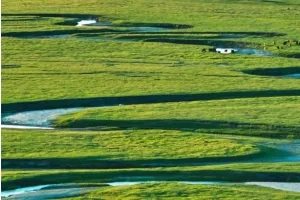Glacier lakes are a type of lakes formed by depressions and moraines excavated by glaciers that block water in glacier troughs.
Glacier lakes are formed by the erosion of glaciers. Glacier lakes are generally distributed at higher altitudes, while the lakes are smaller, and most of them are small lakes with exits. Glaciers are solid water, and when approaching spring, glaciers begin to melt, and unmelted glaciers are like rocks surrounding the melted water. Next, we will introduce some famous ice lakes to you.
1. Lake Bled
It is located at the southern foot of the Alps. From a geological point of view, it is a lake formed by the melting of glaciers. The snow on the top of the mountain is melted, and the clear springs in the mountains continue to pour into the lake, so it has the reputation of "ice lake". Lake Bled has beautiful scenery and crystal clear water. Swans, wild ducks and some other waterfowl swim in the lake. The surrounding mountains are full of green trees and green grass. The snow peaks of the Alps are clearly visible in the sunlight. As beautiful as a landscape painting. It is the most famous lake in Slovenia. However, it is only 500-180 meters wide and 30 meters deep. Although the lake is not big, it is really beautiful. Many people come to see Lake Bled and are reluctant to leave. They will stay longer.
2. Glacier Lake
Located on Vatnajökull Glacier, the Glacier Lagoon is the largest and most famous glacial lake in Iceland. The bottom of the lake is 200 meters deep, making it the second deepest lake in Iceland. The water of the glacial lake is blue and clear, and many large ice blocks of various shapes float on the lake surface. Taking an amphibious boat on the glacial lake to watch the floating ice of various shapes is a major feature of the tour. The surface of the lake is all covered with floating ice, and in the early morning, there is only the sound of water currents colliding with ice cubes. The ice is caused by the continuous collapse of the giant ice on the Vatnajökull Glacier. Imagine that the ice age of that year may also be the same beauty.
3. Argentine Ice Lake
Located at 50 degrees south latitude, Argentine Lake covers an area of 1,414 square kilometers and is 215 meters above sea level. The lake drains eastwards into the Santa Cruz River and into the Atlantic Ocean. Argentine Lake is surrounded by snow-capped mountains with beautiful scenery. Along the way, the sunrise at high latitudes reflects the pristine desert land. The snow-capped mountains are looming and layered under the entanglement of clouds and mist. The lake water is blue and clear, and the scenery is intoxicating. When the sunrise and sunset leave the earth, under the blue sky and white clouds, the deep blue lake and the surrounding snow-capped peaks complement each other.


